-
 NEWFrench illustrated pornographic magazine (ouvrage illustrè de photographies pornographiques), in pictorial wrappers, 235 x 160 mm, 16 leaves incl. wrappers, unpaginated.
NEWFrench illustrated pornographic magazine (ouvrage illustrè de photographies pornographiques), in pictorial wrappers, 235 x 160 mm, 16 leaves incl. wrappers, unpaginated. -
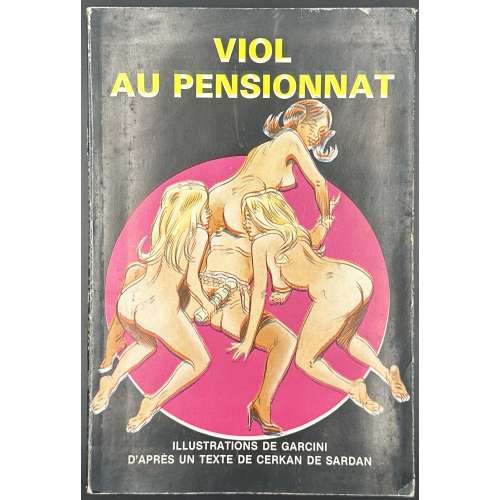 NEWSoftcover, French flapped pictorial wrappers, 240 x 160 mm, translated title: Rape at the boarding school, pp. [1-6] 7-164 [4], 40 black and white illustrations by Garcini. Title-page: D’après un texte de | CERKAN DE SARDAN | VIOL | AU PENSIONNAT | illustrations de | GARCINI ||
NEWSoftcover, French flapped pictorial wrappers, 240 x 160 mm, translated title: Rape at the boarding school, pp. [1-6] 7-164 [4], 40 black and white illustrations by Garcini. Title-page: D’après un texte de | CERKAN DE SARDAN | VIOL | AU PENSIONNAT | illustrations de | GARCINI || -
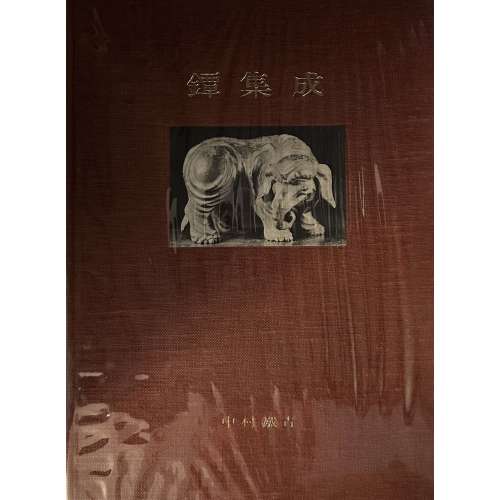 NEWA large hardcover volume, 370 x 265 x 53 mm, bound in burgundy cloth with pasted-in b/w photograph and gilt lettering to front, gilt lettering to spine, in plastic dust jacket, in a slipcase, in a cardboard shipping box, pp. [2] 1-522 [2], 128 leaves total; limited edition of 1000 copies. Author: Nakamura Tessei [中村鐵青] Seller's description: Tsuba Shusei by Nakamura. 1963. Of a limited edition of 1,000. Clothbound with plastic jacket, slipcase, and cardboard storage box, 11 ½ x 14 ½”, 522 heavy stock pages in Japanese. This is a very impressive book. Thousands of tsuba, from Kamakura to late Edo and arranged by school. are illustrated (24 in colour photos and the rest in black & white) and described. If there is a tsuba bible this might be it; there can’t be a more comprehensive book on the subject. The storage box is shelf worn, the slipcase is just a bit toned; the book is in excellentt condition. Produced by Chuokoron-Shinsha, Inc. [株式会社中央公論新社] Publisher: 銀集成刊行会 Production details: 鐵集成 第617番 昭和38年2月10日発行 限定1,000部 定価 10,000円 オフセット単色印刷:マイク印刷 オフセット原色印刷:大日本印刷 著者中村鐵青 製作 中央公論事業出版 発行所 銀集成刊行会 活版印刷:精興社 製本:協和製本 本文用紙:三菱製紙 表紙:望月
NEWA large hardcover volume, 370 x 265 x 53 mm, bound in burgundy cloth with pasted-in b/w photograph and gilt lettering to front, gilt lettering to spine, in plastic dust jacket, in a slipcase, in a cardboard shipping box, pp. [2] 1-522 [2], 128 leaves total; limited edition of 1000 copies. Author: Nakamura Tessei [中村鐵青] Seller's description: Tsuba Shusei by Nakamura. 1963. Of a limited edition of 1,000. Clothbound with plastic jacket, slipcase, and cardboard storage box, 11 ½ x 14 ½”, 522 heavy stock pages in Japanese. This is a very impressive book. Thousands of tsuba, from Kamakura to late Edo and arranged by school. are illustrated (24 in colour photos and the rest in black & white) and described. If there is a tsuba bible this might be it; there can’t be a more comprehensive book on the subject. The storage box is shelf worn, the slipcase is just a bit toned; the book is in excellentt condition. Produced by Chuokoron-Shinsha, Inc. [株式会社中央公論新社] Publisher: 銀集成刊行会 Production details: 鐵集成 第617番 昭和38年2月10日発行 限定1,000部 定価 10,000円 オフセット単色印刷:マイク印刷 オフセット原色印刷:大日本印刷 著者中村鐵青 製作 中央公論事業出版 発行所 銀集成刊行会 活版印刷:精興社 製本:協和製本 本文用紙:三菱製紙 表紙:望月 -
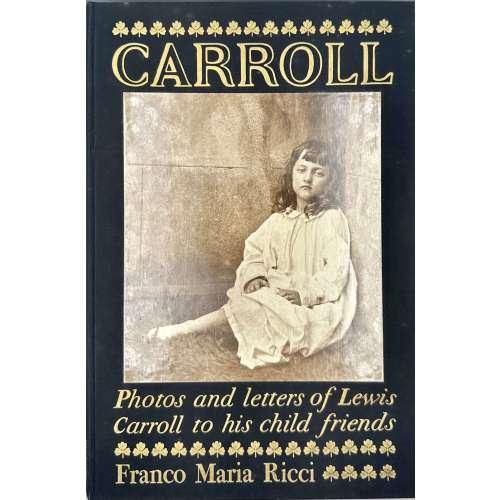 NEWHardcover volume, 355 x 240 mm, bound in black cloth with gilt lettering to front and spine with a photo portrait of Mary Millais (1860-1944), in a black cloth clam-shell box 370 x 253 x 40 mm, with a shamrock diaper black paper adorned with publisher’s coat of arms pasted to the front. Pp.: [1-12] 13-213 [3], with 41 glued-in photomechanically reproduced photographs, chiefly from the Gernsheim Collection at the University of Texas, two of them of Alice Liddell (pp. 123 and 127). Printed on hand-made blue laid paper. Edition is limited to 3,000 copies, of which this is copy № 1200. Title-page: Lewis Carroll | Photos and Letters | to His Child Friends | Edited by Guido Almansi | Notes by | Brassai and Helmut Gernsheim | Franco Maria Ricci | 1975 || Colophon: This volume was printed in Milan, Italy, in the month of November 1975, under the direction of Franco Maria Ricci. The hand-made paper is the work of the Pietro Miliani mills at Fabriano. This first edition consists of three thousand numbered copies. Copy n. [1200]. Facsimile. Seller’s description: Near Fine condition Hardcover Signed by Franco Maria Ricci on the colophon page, Numbered and Limited Edition #1200/3000 of copies. Includes Notes by Brassai and Helmut Gernsheim, with 41 tipped-in sepia-toned photographs, 213 pages. "The Signs of Man Volume 3". Black boards bound in Orient silk with gold engraved lettering on the spine and cover and a sepia-toned photograph affixed to the front cover, handmade Ingres pastel paper manufactured by Cartiere Milliani in Fabrianoo with decorated endpapers and deckled fore-edge. Housed in a black clamshell case with clover leaf pattern in Very Good + condition with the exception that there is no spine label and very light wear to the extremities. Oversize folio: 9" x 13 3/4" Contributors: Carroll, Lewis (British, 1832 – 1898) – Author/Photographer Ricci, Franco Maria (Italian, 1937 – 2020) – publisher Almansi, Guido (Italian, 1931 – 2001) – editor Brassai [Halász, Gyula] (Hungarian–French, 1899 – 1984) – notes Gernsheim, Helmut (Jewish-German, 1913 – 20 July 1995) – notes
NEWHardcover volume, 355 x 240 mm, bound in black cloth with gilt lettering to front and spine with a photo portrait of Mary Millais (1860-1944), in a black cloth clam-shell box 370 x 253 x 40 mm, with a shamrock diaper black paper adorned with publisher’s coat of arms pasted to the front. Pp.: [1-12] 13-213 [3], with 41 glued-in photomechanically reproduced photographs, chiefly from the Gernsheim Collection at the University of Texas, two of them of Alice Liddell (pp. 123 and 127). Printed on hand-made blue laid paper. Edition is limited to 3,000 copies, of which this is copy № 1200. Title-page: Lewis Carroll | Photos and Letters | to His Child Friends | Edited by Guido Almansi | Notes by | Brassai and Helmut Gernsheim | Franco Maria Ricci | 1975 || Colophon: This volume was printed in Milan, Italy, in the month of November 1975, under the direction of Franco Maria Ricci. The hand-made paper is the work of the Pietro Miliani mills at Fabriano. This first edition consists of three thousand numbered copies. Copy n. [1200]. Facsimile. Seller’s description: Near Fine condition Hardcover Signed by Franco Maria Ricci on the colophon page, Numbered and Limited Edition #1200/3000 of copies. Includes Notes by Brassai and Helmut Gernsheim, with 41 tipped-in sepia-toned photographs, 213 pages. "The Signs of Man Volume 3". Black boards bound in Orient silk with gold engraved lettering on the spine and cover and a sepia-toned photograph affixed to the front cover, handmade Ingres pastel paper manufactured by Cartiere Milliani in Fabrianoo with decorated endpapers and deckled fore-edge. Housed in a black clamshell case with clover leaf pattern in Very Good + condition with the exception that there is no spine label and very light wear to the extremities. Oversize folio: 9" x 13 3/4" Contributors: Carroll, Lewis (British, 1832 – 1898) – Author/Photographer Ricci, Franco Maria (Italian, 1937 – 2020) – publisher Almansi, Guido (Italian, 1931 – 2001) – editor Brassai [Halász, Gyula] (Hungarian–French, 1899 – 1984) – notes Gernsheim, Helmut (Jewish-German, 1913 – 20 July 1995) – notes -
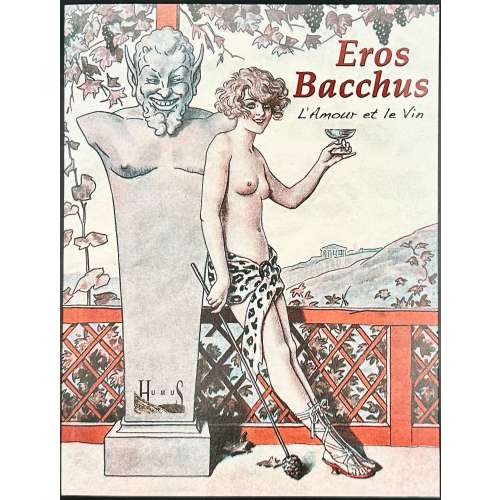 NEWBound in full-colour pictorial wrappers with French flaps, 250 x 190 x 35 mm, 1,311 g by weight, profusely illustrated volume, pp. [1-4] 5-427 [5], 216 leaves total. Title-page: {vignette} | EROS BACCHUS | L'amour et le vin | {publisher's device} || Exhibition at Château Musée du vin et de la vigne, à Aigle, du 24 mai 2014 au 28 février 2015. Text by Michel Froidevaux. Original description : Depuis l'apparition du vignoble, l'amour et le vin sont inséparables. Tantôt boisson des dieux, tantôt breuvage des poètes, le vin a la vertu de rapprocher les êtres. De la riche mythologie antique - Dionysos et Bacchus - aux fêtes des confréries contemporaines, le vin enflamme l'imaginaire et génère de la convivialité. L'idée est de proposer un parcours ludique et culturel, badin et savant pour aller par siècles et contrées à la découverte des plaisirs du boire et des méandres du désir. Livre richement illustré d'un millier d'images (dessins, objets, cartes postales,...) avec la participation d'une quarantaine d'artistes contemporains qui ont créé spécialement une œuvre. Machine translation: Love and wine have been inseparable since the dawn of the vineyard. Sometimes the drink of the gods, sometimes the beverage of poets, wine has the virtue of bringing people together. From the rich mythology of antiquity - Dionysus and Bacchus - to contemporary brotherhood celebrations, wine fires the imagination and generates conviviality. The idea is to offer a playful and cultural journey, both playful and learned, through centuries and lands, to discover the pleasures of drinking and the twists and turns of desire. The book is richly illustrated with some 1,000 images (drawings, objects, postcards, etc.), featuring works by some 40 contemporary artists.
NEWBound in full-colour pictorial wrappers with French flaps, 250 x 190 x 35 mm, 1,311 g by weight, profusely illustrated volume, pp. [1-4] 5-427 [5], 216 leaves total. Title-page: {vignette} | EROS BACCHUS | L'amour et le vin | {publisher's device} || Exhibition at Château Musée du vin et de la vigne, à Aigle, du 24 mai 2014 au 28 février 2015. Text by Michel Froidevaux. Original description : Depuis l'apparition du vignoble, l'amour et le vin sont inséparables. Tantôt boisson des dieux, tantôt breuvage des poètes, le vin a la vertu de rapprocher les êtres. De la riche mythologie antique - Dionysos et Bacchus - aux fêtes des confréries contemporaines, le vin enflamme l'imaginaire et génère de la convivialité. L'idée est de proposer un parcours ludique et culturel, badin et savant pour aller par siècles et contrées à la découverte des plaisirs du boire et des méandres du désir. Livre richement illustré d'un millier d'images (dessins, objets, cartes postales,...) avec la participation d'une quarantaine d'artistes contemporains qui ont créé spécialement une œuvre. Machine translation: Love and wine have been inseparable since the dawn of the vineyard. Sometimes the drink of the gods, sometimes the beverage of poets, wine has the virtue of bringing people together. From the rich mythology of antiquity - Dionysus and Bacchus - to contemporary brotherhood celebrations, wine fires the imagination and generates conviviality. The idea is to offer a playful and cultural journey, both playful and learned, through centuries and lands, to discover the pleasures of drinking and the twists and turns of desire. The book is richly illustrated with some 1,000 images (drawings, objects, postcards, etc.), featuring works by some 40 contemporary artists. -
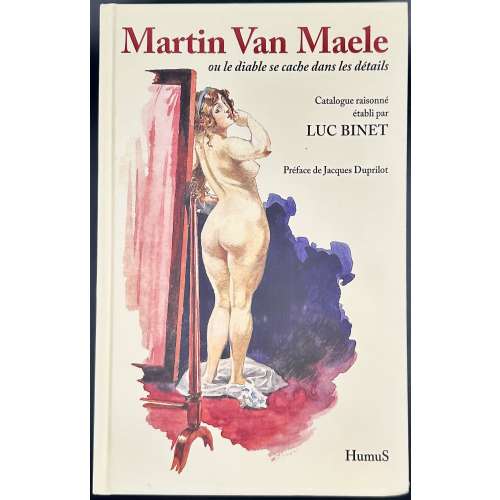 NEWHardcover volume, 292 x 185 x 65 mm, pictorial cream paper over cardboard, black and burgundy lettering to spine and covers; pagination: [4] h.t./imprint, t.p./photo, caption; i-vi, 7-921 [3] colophon; limitation/blank, total 464 leaves. A heavy volume of over 3 kg. Front cover: Martin Van Maele | ou le diable se cache dans détails | Catalogue raisonné | établi par | LUC BINET | Preface de Jacques Duprilot | {vignette} | HumuS || Title-page (red and black): MARTIN VAN MAELE | (1863-1926) | ou le diable se cache dans détails | Catalogue raisonné | établi et commenté par | LUC BINET | Introduction de Jacques Duprilot | {publisher’s device} | ÉDITIONS HUMUS || Edition limited to 333 copies. Maele, Martin van [Martin, Maurice François Alfred] (French, 1863 – 1926)
NEWHardcover volume, 292 x 185 x 65 mm, pictorial cream paper over cardboard, black and burgundy lettering to spine and covers; pagination: [4] h.t./imprint, t.p./photo, caption; i-vi, 7-921 [3] colophon; limitation/blank, total 464 leaves. A heavy volume of over 3 kg. Front cover: Martin Van Maele | ou le diable se cache dans détails | Catalogue raisonné | établi par | LUC BINET | Preface de Jacques Duprilot | {vignette} | HumuS || Title-page (red and black): MARTIN VAN MAELE | (1863-1926) | ou le diable se cache dans détails | Catalogue raisonné | établi et commenté par | LUC BINET | Introduction de Jacques Duprilot | {publisher’s device} | ÉDITIONS HUMUS || Edition limited to 333 copies. Maele, Martin van [Martin, Maurice François Alfred] (French, 1863 – 1926) -
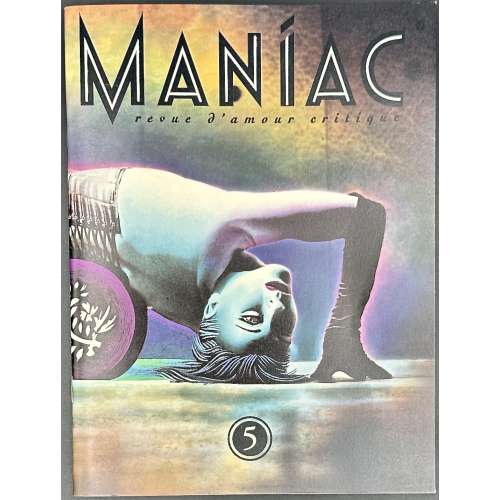 NEWFive issues in publisher's pictorial wrappers, 205 x 155 mm, profusely illustrated French erotic magazines. Published by Éditions Astarté : 58, rue Amelot, 75011 Paris. Rédacteur en chef : Gilles Berquet ; Comité de rédaction : Mïrka Lugosi, Jocelyne and Alexandre Dupouy. Maniac: revue d’amour critique, № 5, octobre 1996, 48p. — Paris: Astarté, 1996 ; ISSN 1261-484X. Maniac: revue d’amour critique, № 6, juin 1997, 48p. — Paris: Astarté, 1996 ; ISSN 1261-484X. Maniac: revue d’amour critique, № 7, octobre 1998, 48p. — Paris: Astarté, 1996 ; ISSN 1261-484X. Maniac: revue d’amour critique, № 8, décembre 2000, 70p (unpag.). — Paris: Astarté, 1996 ; ISSN 1261-484X. Maniac: revue d’amour critique, № 9, janvier 2004, 48p. — Paris: Astarté, 1996 ; ISSN 1261-484X.
NEWFive issues in publisher's pictorial wrappers, 205 x 155 mm, profusely illustrated French erotic magazines. Published by Éditions Astarté : 58, rue Amelot, 75011 Paris. Rédacteur en chef : Gilles Berquet ; Comité de rédaction : Mïrka Lugosi, Jocelyne and Alexandre Dupouy. Maniac: revue d’amour critique, № 5, octobre 1996, 48p. — Paris: Astarté, 1996 ; ISSN 1261-484X. Maniac: revue d’amour critique, № 6, juin 1997, 48p. — Paris: Astarté, 1996 ; ISSN 1261-484X. Maniac: revue d’amour critique, № 7, octobre 1998, 48p. — Paris: Astarté, 1996 ; ISSN 1261-484X. Maniac: revue d’amour critique, № 8, décembre 2000, 70p (unpag.). — Paris: Astarté, 1996 ; ISSN 1261-484X. Maniac: revue d’amour critique, № 9, janvier 2004, 48p. — Paris: Astarté, 1996 ; ISSN 1261-484X. -
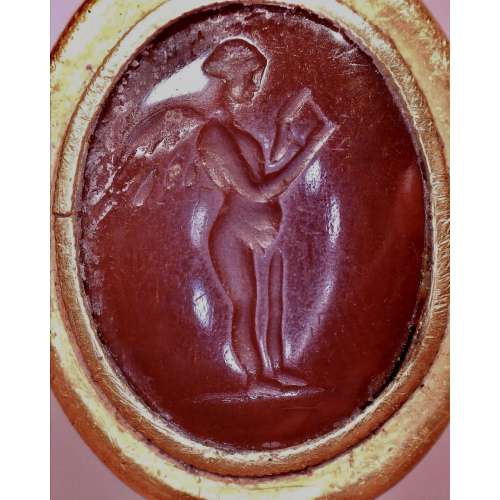 NEWThe intaglio depicts the ancient Greek god Eros looking into a mirror, which he holds in his left hand. Dimensions: 26 x 21 x 20 mm; weight: 11 g. US ring size: 4.25. High-karat gold. Ref.: J. Ogden, A Golden Past: Jewelry from the Ancient World (Catalogue), 1990, p. 10, no. 26 (not seen).
NEWThe intaglio depicts the ancient Greek god Eros looking into a mirror, which he holds in his left hand. Dimensions: 26 x 21 x 20 mm; weight: 11 g. US ring size: 4.25. High-karat gold. Ref.: J. Ogden, A Golden Past: Jewelry from the Ancient World (Catalogue), 1990, p. 10, no. 26 (not seen). -
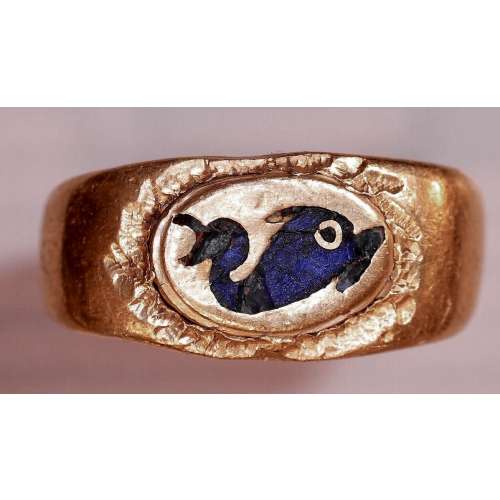 NEWA gold ring with a raised oval face featuring an inlaid blue glass dolphin. Dimensions: 17.7 x 18.8 mm; weight: 4.2 g. US ring size: 4.25. Gold Quality: 96.29% (<23 kt).
NEWA gold ring with a raised oval face featuring an inlaid blue glass dolphin. Dimensions: 17.7 x 18.8 mm; weight: 4.2 g. US ring size: 4.25. Gold Quality: 96.29% (<23 kt). -
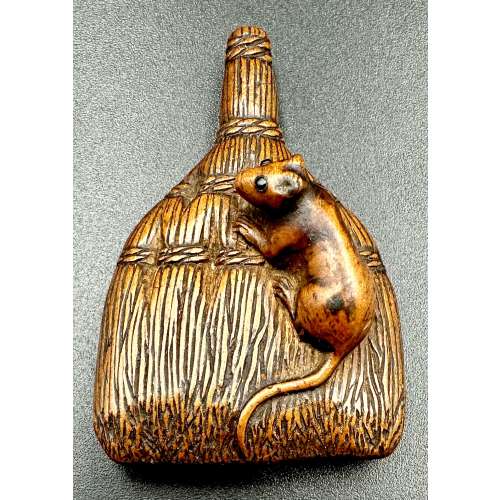 NEWFinely carved as a rat (nezumi) seated on a shuro brush, bound naturalistically with thick bristles. The rodent with a long trailing tail and eyes inlaid in a dark horn. Generously excavated, asymmetrical himotoshi to the underside. According to Merrily Baird (Symbols of Japan, p. 156): …The Japanese do not clearly differentiate between the rat and the mouse, and one word, nezumi [鼠], designates both. …Rat is a messenger of Daikokuten, a deity of grain and vegetation who is one of Japan’s Seven Gods of Good Luck. ...Depictions of the rat are most common in years of the zodiac represented by the animal. Late 18th century. Dimensions: 49 x 33 x 16 mm. Provenance: From the private collection of Armand Basi (Spanish, 1924-2009).
NEWFinely carved as a rat (nezumi) seated on a shuro brush, bound naturalistically with thick bristles. The rodent with a long trailing tail and eyes inlaid in a dark horn. Generously excavated, asymmetrical himotoshi to the underside. According to Merrily Baird (Symbols of Japan, p. 156): …The Japanese do not clearly differentiate between the rat and the mouse, and one word, nezumi [鼠], designates both. …Rat is a messenger of Daikokuten, a deity of grain and vegetation who is one of Japan’s Seven Gods of Good Luck. ...Depictions of the rat are most common in years of the zodiac represented by the animal. Late 18th century. Dimensions: 49 x 33 x 16 mm. Provenance: From the private collection of Armand Basi (Spanish, 1924-2009). -
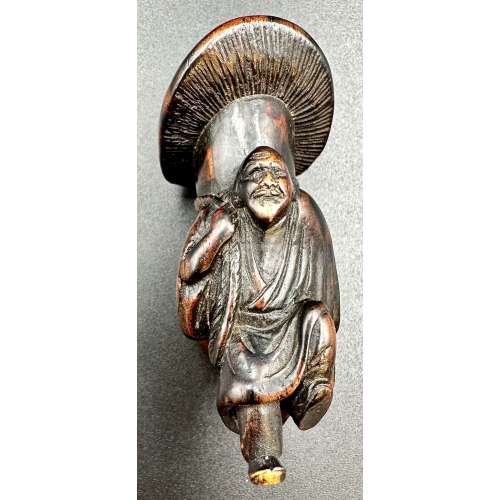 NEW
NEWNetsuke with a design of an old man carrying a giant mushroom on his back. Possibly signed on his left foot. According to Merrily Baird (Symbols of Japan, page. 93): ... This prominent use in the symbol-rich netsuke art form, however, reflects more their sexual symbolism than either their dietary appeal or interesting shapes. Mushrooms in Japan are generally a symbol of fertility, with some flat varieties, like shiitake, being associated with females. In contrast, the matsutake mushroom (Armillaria edodes) is a phallic symbol, as befits its thick, spearlike stem and the fact that it is consumed before cap opens.
Seller's description: "The old man carved walking, with one foot slightly raised, wearing a loose fitted robe and carrying a large long-stemmed mushroom on his back. The wood stained and bearing a fine patina. Himotoshi through the mushroom stem". See VO-0270.2018 for the same subject. Late 18th century. Dimensions: 62 mm tall -
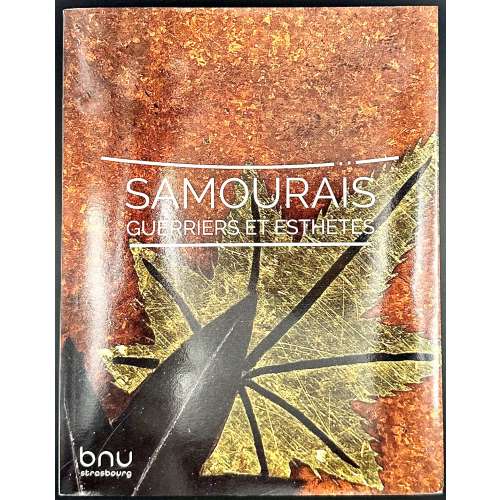 NEWSoftcover, 270 x 210 mm, publisher’s flapped pictorial wrappers, in identical dust jacket, pp. [1-4] 5-189 [3], illustrated throughout with 192 collection items. ISBN 978-2-85923-092-0 Title-page (sanguine): — | SAMOURAÏS | GUERRIERS ET ESTHÈTES | — | CATALOGUE DE L'EXPOSITION | ORGANISÉE A LA BIBLIOTHÉQUE | NATIONALE ET UNIVERSITAIRE | STRASBOURG | 11 MARS – 13 JUILLET 2022 | SOUS LA DIRECTION | DE PATRICK LIEBERMANN, | EMMANUEL MARINE | ET DELPHINE MULARD | ASSISTÉS PAR AGATHE JACQUEMIN | bnu | STRASBOURG || Publisher: Bibliothèque Nationale et Universitaire (Strasbourg) In this collection: TSU-0437.2024
NEWSoftcover, 270 x 210 mm, publisher’s flapped pictorial wrappers, in identical dust jacket, pp. [1-4] 5-189 [3], illustrated throughout with 192 collection items. ISBN 978-2-85923-092-0 Title-page (sanguine): — | SAMOURAÏS | GUERRIERS ET ESTHÈTES | — | CATALOGUE DE L'EXPOSITION | ORGANISÉE A LA BIBLIOTHÉQUE | NATIONALE ET UNIVERSITAIRE | STRASBOURG | 11 MARS – 13 JUILLET 2022 | SOUS LA DIRECTION | DE PATRICK LIEBERMANN, | EMMANUEL MARINE | ET DELPHINE MULARD | ASSISTÉS PAR AGATHE JACQUEMIN | bnu | STRASBOURG || Publisher: Bibliothèque Nationale et Universitaire (Strasbourg) In this collection: TSU-0437.2024
 Contributors Collective:
Emmanuel Marine
Delphine Mulard
Patrick Liebermann
Agathe Jacquemin
Contributors Collective:
Emmanuel Marine
Delphine Mulard
Patrick Liebermann
Agathe Jacquemin -
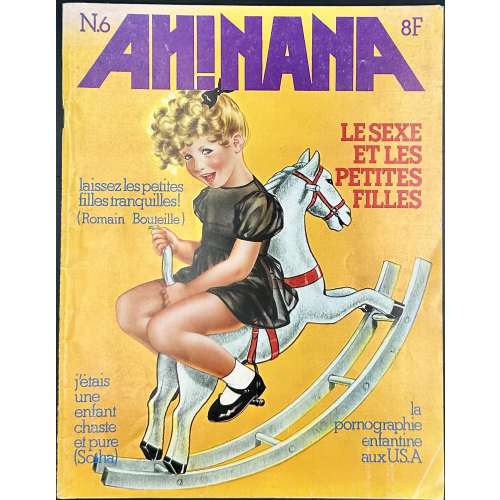 NEWSoftcover, 270 x 210 mm, trimestrial comics magazine AH!NANA published by Les Humanoïdes Associés in Paris from October 1976 to September 1978, running issues 1 to 9. This is issue № 6, printed in 1977, 68 pp., incl. covers in colour by Liz Bijl. Authors/Artists include: Nicole Claveloux, Chantal Montellier, Marie-Noëlle Pichard, Shary Flenniken, Trina Robbins, Cécilia Capuana, and Marianne Leconte.
NEWSoftcover, 270 x 210 mm, trimestrial comics magazine AH!NANA published by Les Humanoïdes Associés in Paris from October 1976 to September 1978, running issues 1 to 9. This is issue № 6, printed in 1977, 68 pp., incl. covers in colour by Liz Bijl. Authors/Artists include: Nicole Claveloux, Chantal Montellier, Marie-Noëlle Pichard, Shary Flenniken, Trina Robbins, Cécilia Capuana, and Marianne Leconte. -
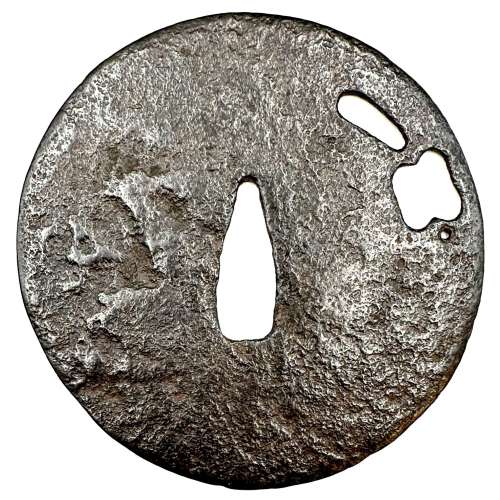 NEWThin plate iron tsuba of round form with a military commander's fan (gunbai) design in openwork (sukashi); Ko-tosho school. Kamakura period (1185 – 1333), 13th to early 14th century (according to Nakamura Tessei). Dimensions: 91.2 x 89.5 mm, thickness: 1.5-2.5 mm. Provenance: Patrick Liebermann Collection. Reproduced in the exhibition catalogue Samurai. Guerriers et esthètes, BNU, Strasbourg, March 11 – July 13, 2022, №045, p.91 and in Patrick Liebermann, Tsuba. Itinéraires d'une collection, 2016, №72, p.111. Reference: a similar tsuba reproduced in LIB-3304.2024 (see below) and in this collection TSU-0332.2017 (provenance Sasano Masayuki).
NEWThin plate iron tsuba of round form with a military commander's fan (gunbai) design in openwork (sukashi); Ko-tosho school. Kamakura period (1185 – 1333), 13th to early 14th century (according to Nakamura Tessei). Dimensions: 91.2 x 89.5 mm, thickness: 1.5-2.5 mm. Provenance: Patrick Liebermann Collection. Reproduced in the exhibition catalogue Samurai. Guerriers et esthètes, BNU, Strasbourg, March 11 – July 13, 2022, №045, p.91 and in Patrick Liebermann, Tsuba. Itinéraires d'une collection, 2016, №72, p.111. Reference: a similar tsuba reproduced in LIB-3304.2024 (see below) and in this collection TSU-0332.2017 (provenance Sasano Masayuki).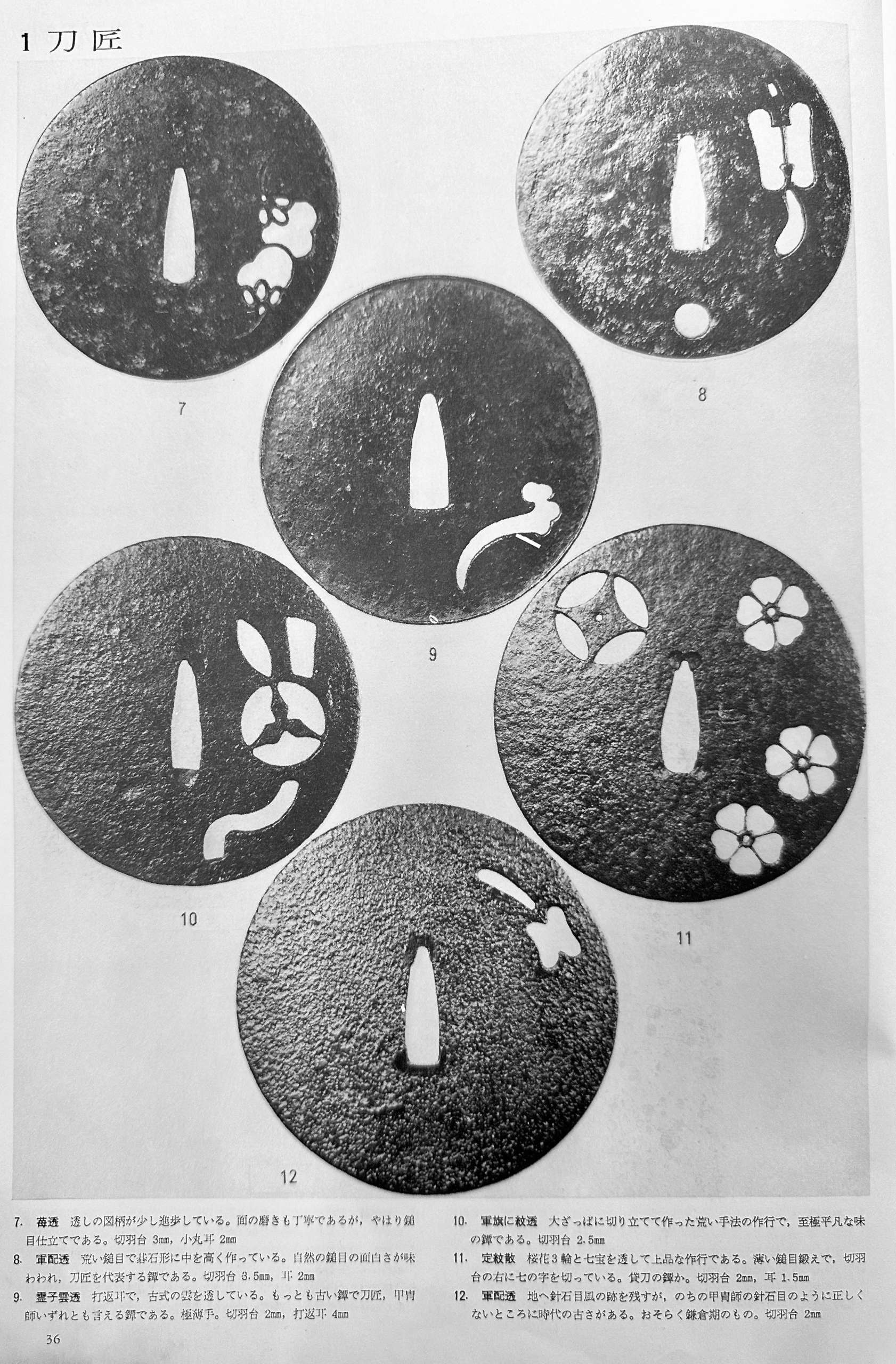
Tsuba Collection (Tsuba shūsei, 鐔集成) by Nakamura Tessei (中村鐵青), p.36, fig. 12.
-
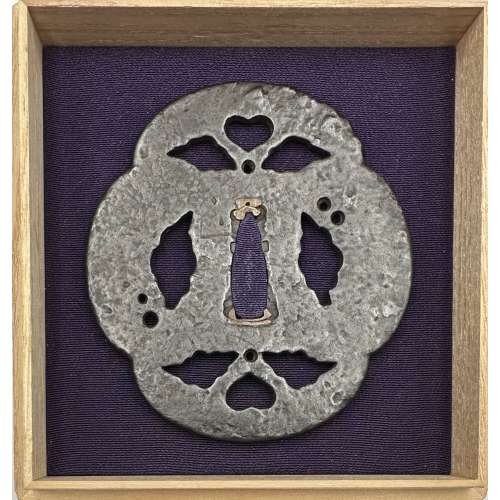 NEW
NEWLarge iron tsuba of mokko form with the openwork (sukashi) design, described by some as rotten leaves swirling in the wind and boar eyes (inome, 猪目, heart-shaped elements); round rim (maru-mimi); no hitsu-ana; pronounced iron bones (tekkotsu); chocolate patina.
Signed to the left of nakaga-ana: Yamakichibei (山吉兵へ). Attributed to the First Generation (Shodai) master.
Dimensions: 90 x 82 mm, thickness 3.7 mm at centre, 4.9 mm at rim. Weight: 142 gReferences: similar handguards demonstrated at Yasukazu's Owari to Mikawa no tankō №176 and Kajima's Tsuba no Bi №28.
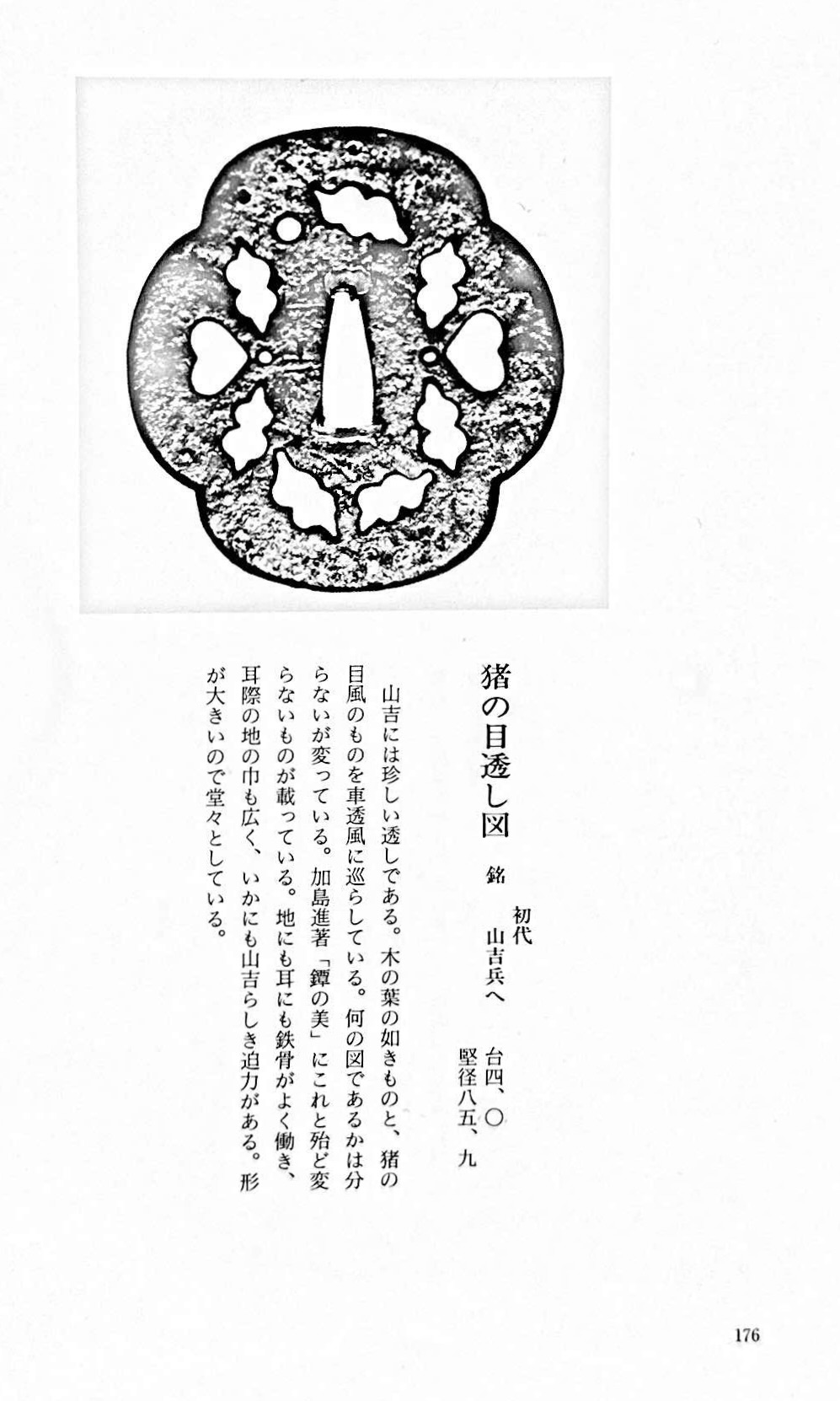
Owari to Mikawa no tankō №176
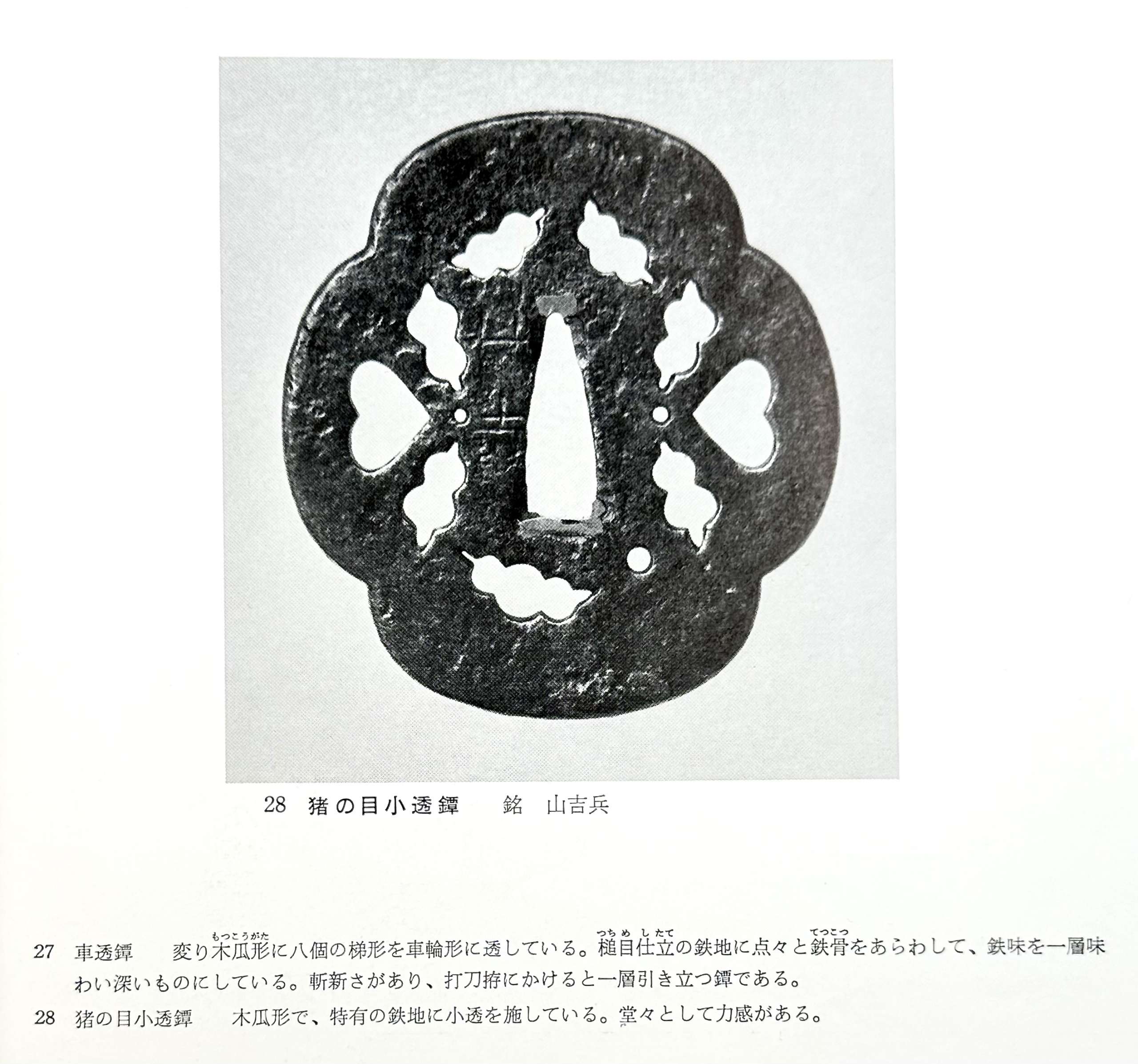
Tsuba no Bi №28
-
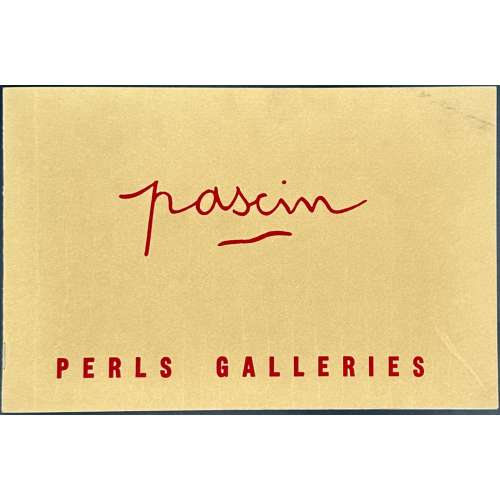 NEWFour exhibition catalogues at Perls Galleries in NYC, coloured stiff laid paper wrappers, colour lettering, staples, b/w plates: September 22 - October 25, 1952, 8 pp; November 14 - December 24, 1955, 12 pp.; “The Nude” January 5 - February 7, 1959. 16 pp.; Portraits and Models November 20 - December 29, 1962, 12 pp. Size: 155 x 240 mm each.
NEWFour exhibition catalogues at Perls Galleries in NYC, coloured stiff laid paper wrappers, colour lettering, staples, b/w plates: September 22 - October 25, 1952, 8 pp; November 14 - December 24, 1955, 12 pp.; “The Nude” January 5 - February 7, 1959. 16 pp.; Portraits and Models November 20 - December 29, 1962, 12 pp. Size: 155 x 240 mm each. -
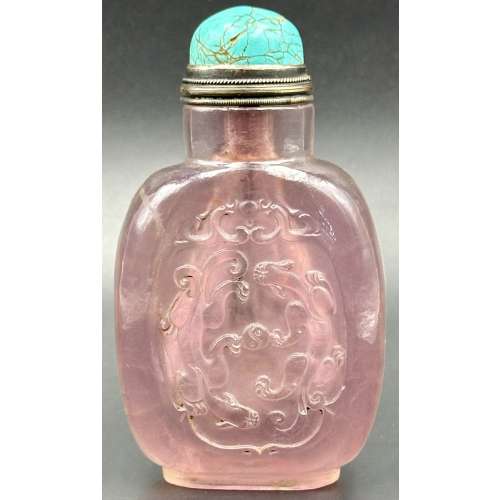 NEWRose quartz snuff bottle of rounded rectangular form on raised foot with round neck, carved in relief with a double dragon in a cartouche; round turquoise stopper with silver collar.
NEWRose quartz snuff bottle of rounded rectangular form on raised foot with round neck, carved in relief with a double dragon in a cartouche; round turquoise stopper with silver collar.The Eastern dragon is not the gruesome monster of medieval imagination, but the genius of strength and goodness. He is the spirit of change, therefore of life itself. Hidden in the caverns of inaccessible mountains, or coiled in the unfathomed depth of the sea, he awaits the time when he slowly rouses himself into activity. He unfolds himself in the storm clouds; he washes his mane in the blackness of the seething whirlpools. His claws are in the fork of the lightning, his scales begin to glisten in the bark of rain-swept pine trees. His voice is heard in the hurricane, which, scattering the withered leaves of the forest, a dragon quickens a new spring [C. A. S. Williams. Chinese Symbolism and Art Motifs / 3rd Revised Edition. — Rutland, Vermont & Tokyo, Japan: Charles E. Tuttle Company, 1993].
The Qing dynasty (1644–1911). Mid-19th century. Dimensions: H90 x W52 x D30 mm -
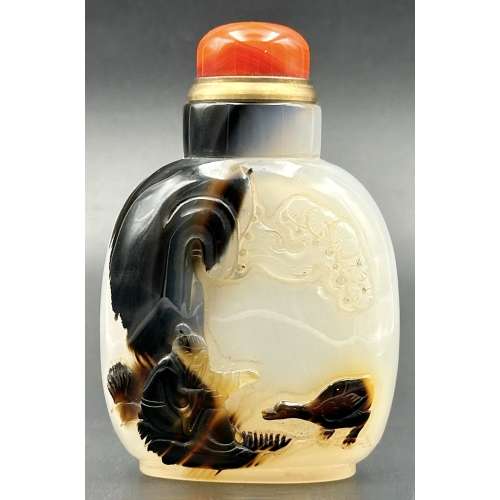 NEWAgate snuff bottle of rounded rectangular form on raised foot with round neck, cream body with dark brown inclusion, carved in relief with a sage seated under a wooded rock, and a duck; round red agate stopper with brass collar. Late 18th or 19th century. The Qing dynasty (1644–1911). Dimensions: H72 x W48 x D28 mm
NEWAgate snuff bottle of rounded rectangular form on raised foot with round neck, cream body with dark brown inclusion, carved in relief with a sage seated under a wooded rock, and a duck; round red agate stopper with brass collar. Late 18th or 19th century. The Qing dynasty (1644–1911). Dimensions: H72 x W48 x D28 mm


